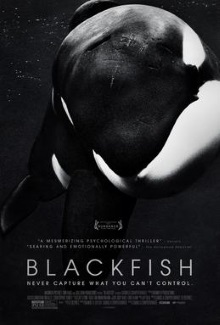
Since I started writing a post about every film that I watch back in March of this year, I have only covered two documentaries. One of these had an agenda that I fundamentally disagree with, but had no reason to dispute its facts such as they were. The other one is essentially a feel-good movie that I liked, but whose less than perfect honesty I had misgivings about. In the case of Blackfish, I approve of its cause and agrees that it succeeds in advancing it, but also believe that it is profoundly unfair and misleading documentary.
Its cause célèbre is to completely stop the keeping of orcas in captivity. To this end, it focuses on one specific animal, Tilikum, and on one specific company, SeaWorld. In particular it argues that orcas in captivity are always dangerous to their human trainers, that Tilikum has an established history of such violence and that SeaWorld knew about this and yet still allowed trainers to swim together with the animal during performances. Special focus is placed on the death of senior trainer Dawn Brancheau, the implication being that if it could happen to such a highly skilled and respected trainer, it could happen to anyone.
The documentary consists mostly of interviews with a smattering of former trainers, activists, an OSHA investigator, a diver who once participated in a hunt for live orcas and so forth, supplemented by archival footage, including news reports and videos of orca performances and also simple computer generated imagery to depict events. For obvious reasons, SeaWorld declined to participate in the project. There is no overarching narrator’s voice, and one of the former trainers takes a more moderate stance, but it is clear that Blackfish is intended as a hit-piece against SeaWorld.
There is no denying that the film tugs very effectively at your heartstrings. For example, in the hunting scene, we see how helicopters are used to track the fleeing orcas until they are forced to return to the surface when they run out of air and how boats are use to corral them in. Then, cranes are used to fish the young ones out of the water, which are the only animals the hunters are interested in. As the tough-looking diver recounts all this, he gradually breaks down into tears, admitting that it was the worst thing he ever did. It’s hard not to shed a few tears alongside him. Similarly heartbreaking scenes abound in this documentary.
Yet if you blink back the tears and cast a critical eye on it, it is also obvious that it engages in rather crass sensationalism. For example, it opens with an audio recording of a telephone call to an EMT immediately after Brancheau’s death that suggests that one of her arms was severed and actually swallowed by Tilikum. But when the tragedy is later covered in the documentary, no mention of this is made and from what I could read online of the event, it never happened. Another example is how the film uses footage to suggest that SeaWorld allows trainers to swim in the water with Tilikum and that Brancheau in particular actually swam with him shortly before the feeding session during which she was killed. Again, this isn’t true as far as I can tell since trainers were never allowed to swim together with Tilikum at any time.
Then there are the inherent contradictions in its stance. It berates SeaWorld for blaming Brancheau for the events that led to her death and takes pains to highlight how Brancheau is one of the most highly respected and experienced trainers. Yet Brancheau voluntarily chose to work with SeaWorld for so long, a decision that presumably suggests that she is comfortable with the company’s safety standards. Similarly some of the most harrowing footage involves another trainer Ken Peters being seemingly toyed with by another orca Kasatka. But Peters continues to work with SeaWorld and has lambasted this documentary, stating that there is risk in any endeavour and he finds the level of risk in working with orcas to be acceptable. There are indeed too many senior trainers who have condemned the documentary to ignore. I find it especially deplorable that one of the trainers who was interviewed for the documentary subsequently criticized it for being substantially different from what was initially shown to her and further claimed that director Gabriela Cowperthwaite asked her not to publicize her criticisms until after the awards season.
All this neither means that I support SeaWorld nor that orcas should be kept in captivity essentially for our entertainment. I am convinced that the animals have a high degree of intelligence and sentience and find claims that the tricks they are trained to perform are just the same things that they do in the wild to be preposterous. I find any statement made by SeaWorld about orcas to be suspect simply because they are a for-profit company and possess every incentive to keep the shows going and minimize any safety or animal welfare issues. Basic logic also indicates to me that contrary to what the company says, any human interaction with an orca is inherently dangerous simply because of how powerful and large they are regardless of the level of training and the safety measures employed.
This is why as much as it pains me to admit it, this is an expertly crafted but fundamentally flawed documentary however much it may succeed in convincing the general public that its cause is just. A better documentary would refrain from sensationalism, present its facts more honestly and engage the broader industry instead of being singularly obsessed with SeaWorld. In other words, it should seek to inform in addition to stirring passions. It seems to me, judging from the other documentaries I’ve seen, that this is a problem that is unique to this format and might well be endemic.
One thought on “Blackfish (2013)”